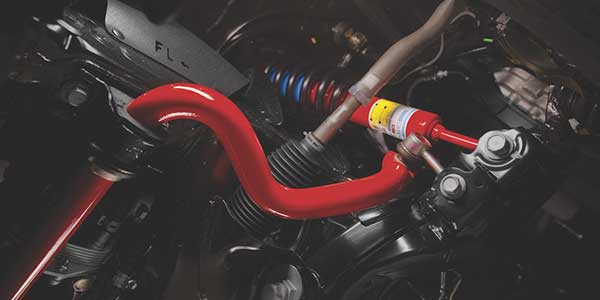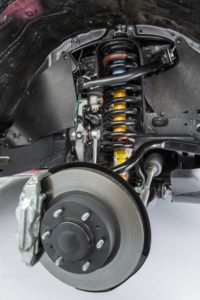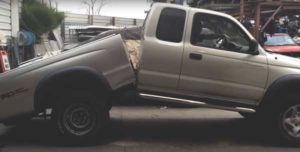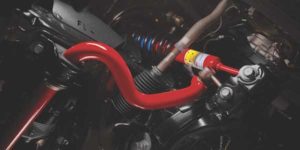Toyota has used the same basic chassis and brake ingredients for its full- and medium-sized trucks and SUVs for almost 20 years.
Whether it is a Tundra, Tacoma or Sequoia, they use a double-wishbone front suspension with a coil-over shock. The upper and lower control arms are made of stamped steel. The knuckle is tall for improved scrub radius, SAI and steering feel. The brakes will typically use an opposed four-piston caliper in the front, and either drum or disc brakes in the rear. A live axle with leaf springs resides in the rear. The Sequoia also received a multi-link suspension mounted to a subframe.
While the parts are not interchangeable, these trucks share a lot of the same problems when it comes to the suspension, brakes and even the frame that we’ll explore in this article.
Frame Corrosion
The biggest problem with these trucks can be corrosion on the frame, not on the body. The most common areas of corrosion are those around the rear leaf spring mounts, transmission cross-member and the frame rails next to the catalytic converters. These are all structural areas of the frame.
The corrosion is not normal surface rust, but rather a full perforation that starts around the welds and then expands. The body may look great, but frame repair costs may exceed the value of the truck, which can make for heartbreaking news for some owners.
In 2016, a class action lawsuit settlement and a Toyota customer satisfaction campaign offered owners of the affected vehicles a free inspection and application of a rust-preventive coating if the corrosion had not damaged the frame in specific areas. If the corrosion was beyond repair, the replacement of the frame was authorized.
In total, the settlement covers more than 225,000 trucks, including the 2005-‘10 Toyota Tacoma, 2007-‘08 Tundra and 2005-‘08 Sequoia models.
The reason why these particular Toyota years and models were affected was due to a manufacturing error that did not properly apply rustproofing materials to the inside and outside of the frame. Other experts have testified that the number of welds in the frame compared to other trucks made these frames more vulnerable to rust.
Owners have a limited time to bring their trucks in for an inspection. So, if you see a 2005-‘10 Toyota truck with extensive frame corrosion, ask the owner if they have received any notices to schedule an inspection. If they have not, advise them to schedule one as soon as possible.
There are several available options to repair corrosion. If a frame needs to be repaired, there are patch panels that can be welded onto the frame. These panels work only on frames that are not too rusty. The patch repair can be labor intensive and might not fully resolve the corrosion issues.
There are chemical options to prevent corrosion in the first place. Some products can convert and encapsulate rust. On some sections of the frame, it is impossible to get complete coverage. Other maintenance products can be manually sprayed on the underside of the vehicle. These products can prevent corrosion problems, but not fix existing corrosion that has perforated the frame.
Brakes
Most 4WD Tundra, Tacoma and Sequoia models come with opposing-piston calipers equipped with four pistons. These calipers are very robust and can take a lot of abuse. The brake pads have a minimum wear specification of 1mm of material before they need to be replaced. There are two rules to follow when servicing four-piston opposed calipers.
First, always use new pins and springs when replacing the brake pads. Reusing the hardware can result in tapered pad wear and noise. The replacement hardware should be plated to prevent corrosion.
There is no need to lubricate the pins, as lubricating the pins can result in debris sticking and preventing pad movement.
Second, the outer ends of the backing plate that make contact with the caliper should be lubricated. This is where the majority of noise is generated. Only a very light layer of lubricant should be applied to the back of the pad. The excess lubricant can become deposited onto the piston boots and attract debris that can damage the boot and seal over time.
Most 2WD models use a single- or dual- floating piston caliper. If the pads are below 2mm, replace the pads. When replacing the pads, make sure you lubricate the shims, clean the caliper bracket and lightly lubricate the abutment clips.
Most 2WD Tundra and Tacoma models use a captured-rotor design. An on-the-car brake lathe can save you time machining the rotor. If the rotor is replaced, make sure you repack the wheel bearings with grease and use a new seal.
The rear drums on the two models work the same way, but how they actuate the parking/emergency brake differs. The 2WD models use a cable that pulls on a lever inside the drum. Toyota recommends pulling on the parking brake handle several times for the final adjustment.
The 4WD models use a bell crank on the backing plate to engage the parking brake. It is critical to make sure the tension is correct and that there is a gap of 0.4-0.8 mm between the backing plate and adjusting bolt on the bell crank with the parking brake engaged.
Bleeding the brakes can be done using many methods. It is recommended to start with the valve before bleeding the rear brakes. Begin air bleeding from the wheel cylinder with the longest hydraulic line first.
Alignment
Toyota has built-in cam adjusters in the lower control arms that provide ±1º of camber or caster. Aftermarket upper control arms with adjustable ball joints can provide increased camber and caster adjustments to accommodate larger tires and suspension lifts.
The rear suspension is not adjustable, but measurements for the thrust angle and setback should be taken.
Steering Angle Sensor Recalibration
Most of the trucks manufactured after 2004 have ABS and/or vehicle stability control. These vehicles have a process to reset the steering angle, yaw and lateral acceleration sensors called “zero-point calibration.” This process has been used for Toyota vehicles for more than a decade. The TSB for this procedure can be found under brake system TSBs, not steering TSBs.
While performing the zero-point calibration manually or with a scan tool, do not tilt, move or shake the vehicle (don’t get in and out of the truck). The vehicle must remain in a stationary condition throughout the entire process. Be sure to perform the procedure on a level surface with an inclination of less than 1%.
Sequoia Rear Suspension
This system uses air springs instead of the coil springs that are used in a conventional rear suspension. The suspension control ECU analyzes the information based on the switches, sensors and input signals used to operate the compressor assembly, and uses the solenoid valves to control the vehicle height.
In addition, three vehicle heights can be selected by operating the height control switch: HI, NORMAL and LO. The HI vehicle height ensures performance on rough roads. The LO vehicle height facilitates the entry and exit of the occupants and the loading and unloading of cargo. The NORMAL vehicle height helps maintain excellent controllability and riding comfort during normal driving.
The most common failure of these systems is the compressor that wears out and is not able to generate enough pressure. The system will alert the driver with a warning light and message indicating a fault with the air suspension. Also, the system will disable the setup that allows the driver to adjust the height.
For the foreseeable future, Toyota will continue to use the same undercar DNA. What will change are the increased number of sensors and autonomous controls governing the steering and brakes. This will make undercar repairs on Toyota trucks even more critical.
Article courtesy ImportCar.

















